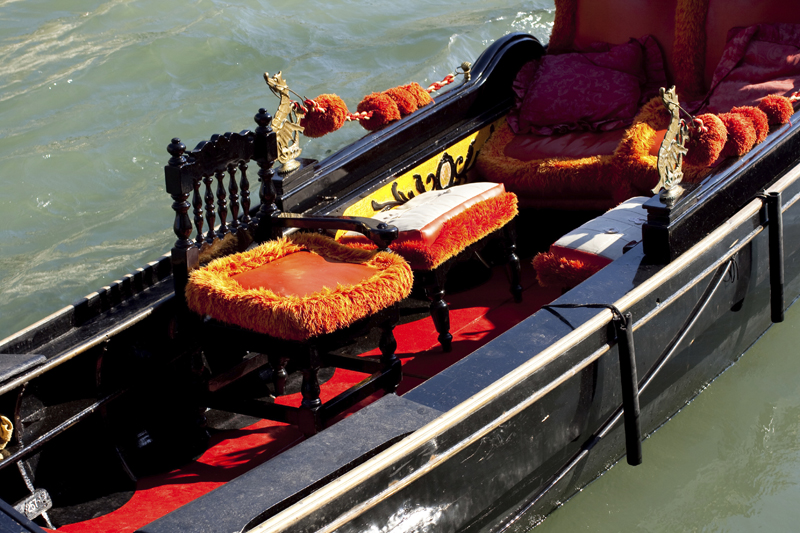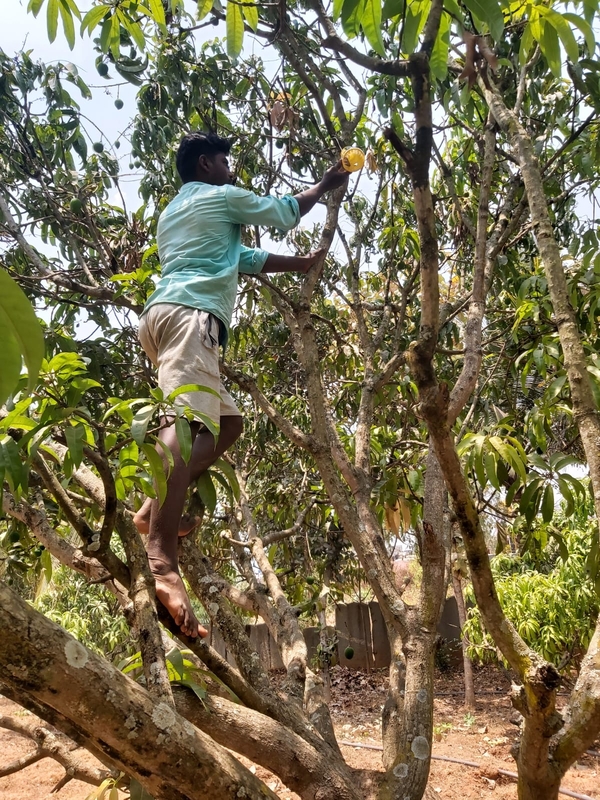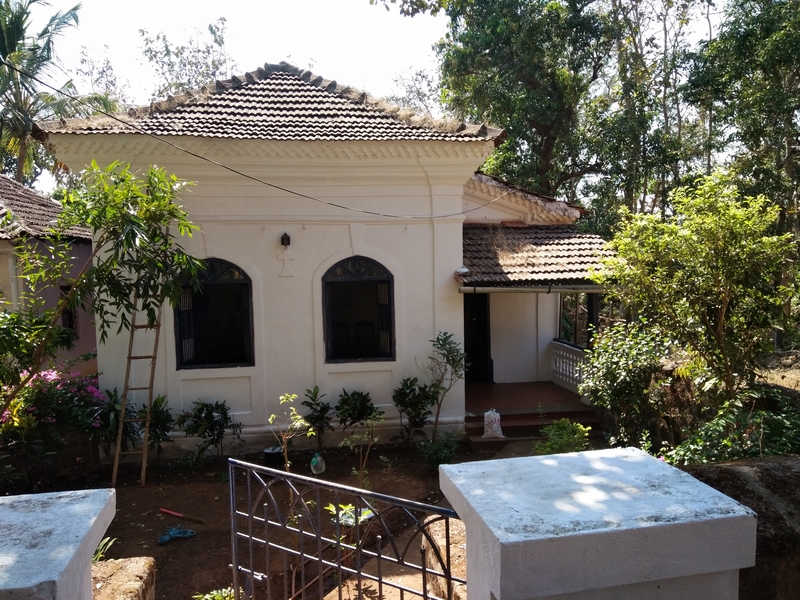Awe inspiring Meenakshi Temple, Madurai, India

Been coming to Madurai University for my PhD work and never been to visit the famous Meenakshi Amman Temple which is a historical Hindu temple located on the southern bank of the Vaigai River in the temple city. So one afternoon when we had the time, we jumped into public auto rickshaws -- public transport three wheelers, and went to the Periyar bus stand.
We were quite stunned that the cost of going to the temple was so nominal by these very unique public transport. Even the buses, may not be fancy, but they were swift and cost just over 10 rupees again. Once we reached the Periyar Bus stand we were told that the temple was just walking distance. Thankfully I had taken my umbrella and that was a great help to keep me safe from the burning sun.
Suddenly after rows of very busy shops and crowded roads, the temple emerges quite unexpectedly. It is a beautiful structure and we stood clicking pictures and staring at its awesome and intricately stuccoed exterior.
The temple is dedicated to goddess Parvati, known as Meenakshi and her consort Shiva, named Sundareswarar in this temple. One can see that the temple forms the heart and lifeline of the 2,500 year old city of Madurai and is a reerred place of devotion for the Tamils. The present structure was built between 1623 and 1655 and it houses 14 Gopurams (gateway towers), ranging from 45–50m in height. The tallest is the southern tower,170 ft high, with two golden sculptured , the shrines over the garbhagrihas(sanctums) of the main deities.
The temple attracts 15,000 visitors a day, around 25,000 on Fridays, and receives an annual revenue of sixty million rupees. There are an estimated 33,000 sculptures in the temple and It was on the list of top 30 nominees for the New Seven Wonders of the Wolrd. The annual 10-day Meenakshi Tirukalyanam festival, celebrated during April and May, attracts 1 million visitors.
The temple is one of the largest temple complexes in Tamil Nadu and the temple complex is divided into a number of concentric quadrangular enclosures contained by high typically striped walls. It is one of the few temples in Tamil Nadu to have four entrances facing four directions.
The city was laid out in the shape of square with a series of concentric streets culminating from the temple.
The complex is in around 45 acres large. The temple is surrounded by Gopurams or gateway towers. There are ten gopurams and the tallest of which, the famous southern tower, rises to over 170 ft and was built in 1559. The oldest gopuram is the eastern one, built by Maravarman Sundara Panduring during 1216-1238. Each gopuram is a multi-storeyed structure, covered with thousands of stone figures of animals, gods and demons painted in bright colours. The outer gopuram presents steeply pyramidal tower encrusted with plaster figures, while the inner gopuram serves as the entrance to the inner enclosure of Sundareswarar shrine.
There is also the Meenakshi Nayakkar Mandapam or "Hall of 100 pillars" which has two rows of pillars carved with images of Yali the mythological beast with body of lion and head of an elephant, commonly used as the symbol of Nayak power. It is situated to the north of Sundareswarar flag staff hall. The Thousand Pillar Hall contains 985 (instead of 1000) carved pillars. This hall was built by Ariyanantha Mudaliar in 1569 and blends engineering skill and creativity. There are close to 50 priests in the temple who perform the puja orrituals during festivals and on a daily basis.
We were quite stunned that the cost of going to the temple was so nominal by these very unique public transport. Even the buses, may not be fancy, but they were swift and cost just over 10 rupees again. Once we reached the Periyar Bus stand we were told that the temple was just walking distance. Thankfully I had taken my umbrella and that was a great help to keep me safe from the burning sun.
Suddenly after rows of very busy shops and crowded roads, the temple emerges quite unexpectedly. It is a beautiful structure and we stood clicking pictures and staring at its awesome and intricately stuccoed exterior.
The temple is dedicated to goddess Parvati, known as Meenakshi and her consort Shiva, named Sundareswarar in this temple. One can see that the temple forms the heart and lifeline of the 2,500 year old city of Madurai and is a reerred place of devotion for the Tamils. The present structure was built between 1623 and 1655 and it houses 14 Gopurams (gateway towers), ranging from 45–50m in height. The tallest is the southern tower,170 ft high, with two golden sculptured , the shrines over the garbhagrihas(sanctums) of the main deities.
The temple attracts 15,000 visitors a day, around 25,000 on Fridays, and receives an annual revenue of sixty million rupees. There are an estimated 33,000 sculptures in the temple and It was on the list of top 30 nominees for the New Seven Wonders of the Wolrd. The annual 10-day Meenakshi Tirukalyanam festival, celebrated during April and May, attracts 1 million visitors.
The temple is one of the largest temple complexes in Tamil Nadu and the temple complex is divided into a number of concentric quadrangular enclosures contained by high typically striped walls. It is one of the few temples in Tamil Nadu to have four entrances facing four directions.
The city was laid out in the shape of square with a series of concentric streets culminating from the temple.
The complex is in around 45 acres large. The temple is surrounded by Gopurams or gateway towers. There are ten gopurams and the tallest of which, the famous southern tower, rises to over 170 ft and was built in 1559. The oldest gopuram is the eastern one, built by Maravarman Sundara Panduring during 1216-1238. Each gopuram is a multi-storeyed structure, covered with thousands of stone figures of animals, gods and demons painted in bright colours. The outer gopuram presents steeply pyramidal tower encrusted with plaster figures, while the inner gopuram serves as the entrance to the inner enclosure of Sundareswarar shrine.
There is also the Meenakshi Nayakkar Mandapam or "Hall of 100 pillars" which has two rows of pillars carved with images of Yali the mythological beast with body of lion and head of an elephant, commonly used as the symbol of Nayak power. It is situated to the north of Sundareswarar flag staff hall. The Thousand Pillar Hall contains 985 (instead of 1000) carved pillars. This hall was built by Ariyanantha Mudaliar in 1569 and blends engineering skill and creativity. There are close to 50 priests in the temple who perform the puja orrituals during festivals and on a daily basis.

Related Articles
Editor's Picks Articles
Top Ten Articles
Previous Features
Site Map
Content copyright © 2023 by Marianne de Nazareth. All rights reserved.
This content was written by Marianne de Nazareth. If you wish to use this content in any manner, you need written permission. Contact Marianne de Nazareth for details.





 -resizeimage.jpg.jpg)

